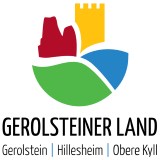Gerolsteiner Dolomiten
Gerolstein
With an area of about 102 hectares, the area around the Gerolstein Dolomites has been designated a nature reserve since 1990.
occurring animal species: bat
common plant species: juniper, orchids, character plants limestone grasslands, beech-wood, forest-meister-beech-wood, orchid-lime-beech-wood
Around 380 million years ago, there was a warm, subtropical flat sea in which massive reefs formed from stromatopores – relatives of sponges – and corals. After the dolomitization, sinking and folding of the rocks, the Devonian deposits were excavated again. The present-day Gerolstein Dolomites were formed, which rise steeply above the Kyll valley north of the centre of Gerolstein. The rocks “Hustley”, “Munterley”, “Drohende Ley”, “Große Kanzel” and “Auberg” shape the cityscape from afar and form Gerolstein’s landmark. The most famous peak of the Gerolstein Dolomites is the "Munterley" - with a height of 482 meters - and offers a breathtaking view over Gerolstein, the Kyll valley and far into the volcanic Eifel. This view was obviously enjoyed by Stone Age people who settled here 30,000 years ago, as evidenced by stone tools and bones found at the nearby Buchenlochhöhle.
Visiting the Gerolstein Dolomites can be combined perfectly with hiking along the rock trail – the northern part of the “Gerolstein Dolomites Eight”. The almost eight-kilometre circular tour offers many magical places and geological traces.
From April to October, a guided adventure hike to the Gerolstein Dolomites takes place every Tuesday at 10:00 a. m. Info/registration: Tourist-Information Gerolstein, Tel. : 06591/13 3100, Mail: touristinfo@gerolsteiner-land. de












